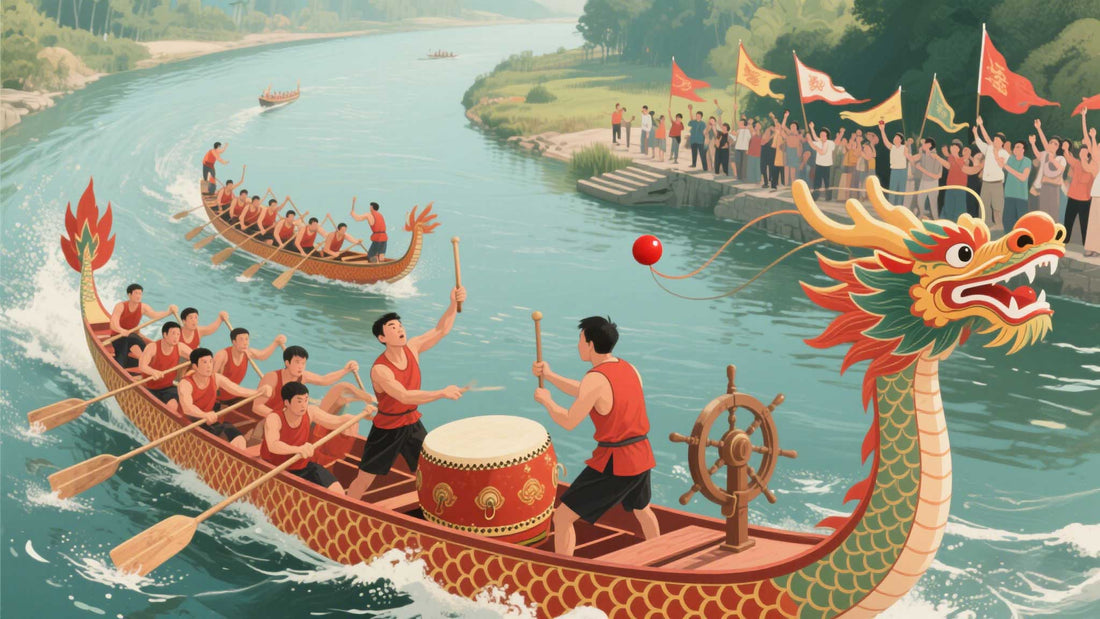
Dragon Boat Festival: From the legend of Qu Yuan to cultural symbol
Share
1. The origin of the Dragon Boat Festival: cultural layers of multiple legends
The most widely known theory about the origin of the Dragon Boat Festival is associated with Qu Yuan (c. 340-278 BC). According to "Records of the Grand Historian: Biographies of Qu Yuan and Jia Yi", this Chu State official committed suicide by jumping into the Miluo River on the fifth day of the fifth month because his political ideals were shattered. The local people rowed boats to salvage the fish in vain, so they threw rice balls into the river to prevent fish and shrimp from biting their bodies. This later evolved into the custom of making rice balls. It is worth noting that there are different versions of the origin of the Dragon Boat Festival, such as the Wu Zixu theory (Wu Yue region) and the Cao E saving her father theory (Huiji region), which reflects the diversity of China's regional culture.
Archaeological discoveries show that long before Qu Yuan, the Yangtze River Basin had already had a sacrificial tradition to drive away epidemics in May. Ying Shao of the Eastern Han Dynasty recorded in "Customs and Meanings": "On May 5th, people tie colorful silk on their arms to ward off war and ghosts and prevent plague." This shows that the Dragon Boat Festival combines the summer solstice customs of the pre-Qin period with the concepts of yin and yang and the five elements.
2. Dragon Boat Race: From a Sacrificial Ceremony to a National Carnival
As the core activity of the Dragon Boat Festival, the evolution of dragon boat racing is quite symbolic:
Sacrifice stage: Early dragon boat races had obvious witchcraft colors. The "Jingchu Sui Shi Ji" records that "dragon boat races are held on May 5th, which is the day when Qu Yuan drowned himself in Miluo River. People mourned his death, so they ordered boats to save him."
Competitive stage: Professional competitions began to appear in the Tang Dynasty. Zhang Jianfeng's "Dragon Boat Race Song" describes it as follows: "Three drum beats, red flags fly, two dragons leap out of the water. The shadows of oars fly across the waves, and the drum beats split the waves like a thousand thunders."
Modern inheritance: The 2010 Guangzhou Asian Games listed dragon boat racing as an official competition event for the first time. Contemporary dragon boat production retains traditional craftsmanship. For example, the Guangdong "Pontianak Wood" dragon boat requires 18 processes including wood selection, worship of gods, and cutting of materials.
3. The Imagery of Dragon Boat Festival in Poetry
The Dragon Boat Festival poems written by literati of all dynasties constitute a unique cultural landscape:
1. Du Fu's "Giving Clothes on the Dragon Boat Festival"
"The palace clothes are also famous, and they are honored during the Dragon Boat Festival. The fine gauze is soft in the wind, and the fragrant silk is light as snow."
The details of the imperial summer clothes are used to show the etiquette of the Dragon Boat Festival in the Tang Dynasty court. The images of hemp cloth and incense silk coincide with the seasonal characteristics of "the Dragon Boat Festival marks the beginning of summer".
2. Su Shi's "Huanxisha·Dragon Boat Festival"
"Colored threads lightly wrap around red jade arms, small charms hang diagonally on green cloud hair. The beauty will see you for a thousand years."
The "colored thread" and "small talisman" in the lyrics correspond to the custom of longevity thread recorded in "Jingchu Sui Shi Ji", sublimating folk objects into tokens of love.
3. Lu You's "Poems of the Fifth Month of Yimao"
"The rice dumplings are divided into two buns, and the moxa is tied to the crown. According to the old custom, medicine is stored in the square, and the frail body is also painted with elixir."
Recording the medicinal culture of the Southern Song Dynasty, objects such as mugwort and cinnabar constitute a vivid slice of ancient public health practices.
